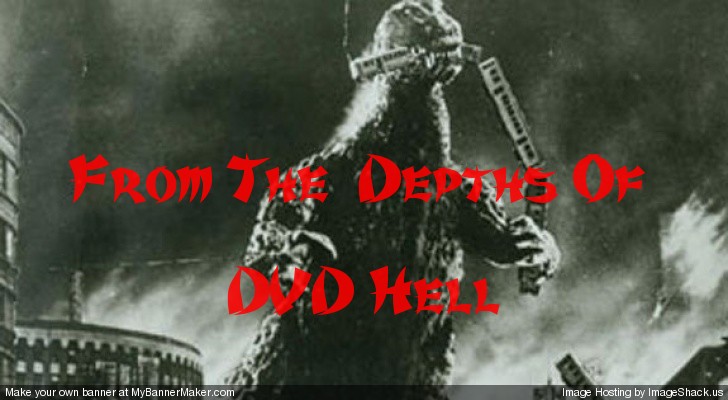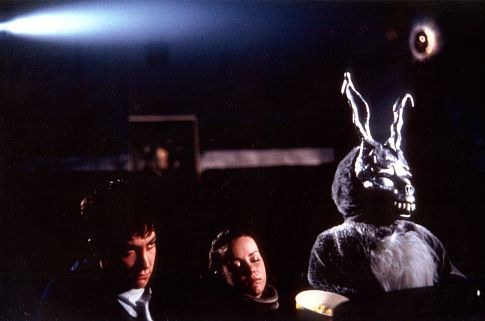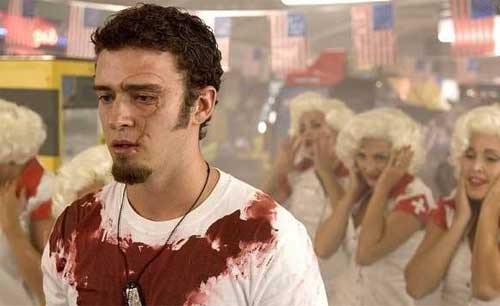
Currently here in the UK, they are attempting to flog a dead horse as thanks to zero public demand whatsoever “Big Brother” has been brought back from the TV Graveyard for yet another series, as fame hungry wannabe’s sit around and become voyeur fodder for the general public….well this would usually be the case if anyone was actually watching. Still what better time to finally watch Charlie Brooker’s satire of the Big Brother phenomenon as he brings a horror twist to things by introducing hordes of frenzied zombies.
Set during a fictional season of “Big Brother” (the makers of which bizarrely are also behind this satire), we open on eviction night were the latest housemate is set to leave the house, while meanwhile the Britain is being rocked by widespread riots. Struggling to keep the show running smoothly, show runner Kelly (Jaime Winstone) also has to deal with her foul mouthed and abusive boss Patrick (Andy Nyman). Things only get worse when a man bitten earlier by a zombie breaks into the crowd causing mass infection to breakout as the crowd are quickly infected turning them into a rampaging horde which soon breaks into the studio and turning the Big Brother house into the sole sanctuary from the zombie hordes, while the housemates continue with the show unaware of the chaos erupting outside of the house.
Originally shown weeks after the end of the ninth series of “Big Brother”, Charlie Brooker’s take on the show not only manages to satire the show with his usual sharp humour and keen eye for the smallest of details, but he has also managed to find an original zombie plot, which is certainly no easy task especially with so many zombie films being churned out in the last few years, usually as direct to video efforts and more often than not recycling for the umpteenth time the same tired storylines.
The fictional housemates are very much like their real life counter parts, with Brooker drawing inspiration from several of the more memorable housemates, while the group on the whole are the usual group of fame hungry wannabe’s with perhaps the exception of Joplin (Kevin Eldon) whose is attempting to use the show as his own soapbox for his own views on society. Meanwhile the rest of the group are happily playing up for the cameras while they live blissfully unaware in their own little world, which has been created by the show. Due to their lack of contact with the outside world, they are quick to dismiss Kelly as another task that the producers have set for them and it’s only after Kelly turns a zombie’s head into a pancake using a fire extinguisher, that they finally except that something might be not quite right.
Outside of the housemates, the series also follows Kelly’s boyfriend Riq (Riz Ahmed) who having been left stranded at a train station after his car is stolen is attempting to make it to the studio to reunite with her, also unaware of the chaos erupting at the studio, were Studio boss and general selfish bastard Patrick and recent show evictee Pippa (Kathleen McDermott) are holed up from the zombies currently roaming the studio hallways after the initial rampage has subsided. The three storylines soon becoming entwined into a single story once the groups reunite, but help to give a full picture of the outbreak with Riq teaming up with a fellow survivor Alex (Liz Mae Brice) who certainly is more clued up on the situation than most of the characters, having already gotten hold of a firearm and running on full blown survivor mode, especially shown by the fact she has sourced a rifle which seeing how this is England is certainly not an easy thing, especially with the Firearm laws making guns anything but readily available to members of the general public, which is an aspect sadly not highlighted further, a minor plot niggle not only with this series but any of the previous British Zombie films which came before it.
Brooker has seemingly wrote “Dead Set” to be made on a small budget, especially with the action taking place mainly in two key locations, which are the Big Brother house and the studio, though we do get a few moments of the world outside the studio, via Riq’s own journey with Alex from the train station which takes him through abandoned villages and woods and it’s almost refreshing to not see another attempt at the epic abandoned cityscapes of “28 Days Later” (2002) and by keeping the action in a decidedly rural setting it gives the audience something they haven’t seen done a hundred times before, which when it comes to the zombie genre is no easy task. Still little focus is given to the so called real world outside of these glimpses with the few scenes outside of the studios only furthering the impression that it might be the safest place for them, while helping to give a real sense of isolation from any form of uninfected humanity, while seemingly automated radio broadcasts try to maintain calm amongst the general public, while advising of the country being evacuated to France.
The biggest surprise here though is just how visceral the violence is, especially when it was originally shown as a five part TV series, which would normally mean holding back on the violence, only here it pretty much pushes it way beyond anything we have seen in recent zombie films as these zombies are a real throw back to the gut munchers of the 80’s, as bodies are torn apart as entrails are pulled from torsos with sadistic glee with Brooker openly admitting that he drew inspiration from George A. Romero’s Dead saga, as clearly homaged by one of the characters expletive heavy death which is almost a straight copy of Capt. Rhodes’ death from “Day of the Dead” (1985). The majority of the heavy violence is saved for the rampage finale, which again has a similar feel to the finale of “Dawn of the Dead” (1978), yet Brooker has still managed to craft enough original shocks to make this more than a George Romero highlight reel, as Fire extinguishers, scissors and hatchets are just a few of the makeshift weapons used in the fight against the undead hordes, while also answering the question “Do Zombies enjoy hot tubs?”
Unsurprisingly these are not the same shuffling hordes that Romero favours, but instead the more modern frenzied kind, with “28 Days Later” being a big inspiration clearly for the visual style of the series, especially with the heavy use of handheld cameras and shakily shot footage during the attacks, which proves frequently more distracting than dramatic, but with the amount of gore on display throughout it does at least make up in spades for what your not getting to see.
Set during a fictional season of “Big Brother” (the makers of which bizarrely are also behind this satire), we open on eviction night were the latest housemate is set to leave the house, while meanwhile the Britain is being rocked by widespread riots. Struggling to keep the show running smoothly, show runner Kelly (Jaime Winstone) also has to deal with her foul mouthed and abusive boss Patrick (Andy Nyman). Things only get worse when a man bitten earlier by a zombie breaks into the crowd causing mass infection to breakout as the crowd are quickly infected turning them into a rampaging horde which soon breaks into the studio and turning the Big Brother house into the sole sanctuary from the zombie hordes, while the housemates continue with the show unaware of the chaos erupting outside of the house.
Originally shown weeks after the end of the ninth series of “Big Brother”, Charlie Brooker’s take on the show not only manages to satire the show with his usual sharp humour and keen eye for the smallest of details, but he has also managed to find an original zombie plot, which is certainly no easy task especially with so many zombie films being churned out in the last few years, usually as direct to video efforts and more often than not recycling for the umpteenth time the same tired storylines.
The fictional housemates are very much like their real life counter parts, with Brooker drawing inspiration from several of the more memorable housemates, while the group on the whole are the usual group of fame hungry wannabe’s with perhaps the exception of Joplin (Kevin Eldon) whose is attempting to use the show as his own soapbox for his own views on society. Meanwhile the rest of the group are happily playing up for the cameras while they live blissfully unaware in their own little world, which has been created by the show. Due to their lack of contact with the outside world, they are quick to dismiss Kelly as another task that the producers have set for them and it’s only after Kelly turns a zombie’s head into a pancake using a fire extinguisher, that they finally except that something might be not quite right.
Outside of the housemates, the series also follows Kelly’s boyfriend Riq (Riz Ahmed) who having been left stranded at a train station after his car is stolen is attempting to make it to the studio to reunite with her, also unaware of the chaos erupting at the studio, were Studio boss and general selfish bastard Patrick and recent show evictee Pippa (Kathleen McDermott) are holed up from the zombies currently roaming the studio hallways after the initial rampage has subsided. The three storylines soon becoming entwined into a single story once the groups reunite, but help to give a full picture of the outbreak with Riq teaming up with a fellow survivor Alex (Liz Mae Brice) who certainly is more clued up on the situation than most of the characters, having already gotten hold of a firearm and running on full blown survivor mode, especially shown by the fact she has sourced a rifle which seeing how this is England is certainly not an easy thing, especially with the Firearm laws making guns anything but readily available to members of the general public, which is an aspect sadly not highlighted further, a minor plot niggle not only with this series but any of the previous British Zombie films which came before it.
Brooker has seemingly wrote “Dead Set” to be made on a small budget, especially with the action taking place mainly in two key locations, which are the Big Brother house and the studio, though we do get a few moments of the world outside the studio, via Riq’s own journey with Alex from the train station which takes him through abandoned villages and woods and it’s almost refreshing to not see another attempt at the epic abandoned cityscapes of “28 Days Later” (2002) and by keeping the action in a decidedly rural setting it gives the audience something they haven’t seen done a hundred times before, which when it comes to the zombie genre is no easy task. Still little focus is given to the so called real world outside of these glimpses with the few scenes outside of the studios only furthering the impression that it might be the safest place for them, while helping to give a real sense of isolation from any form of uninfected humanity, while seemingly automated radio broadcasts try to maintain calm amongst the general public, while advising of the country being evacuated to France.
The biggest surprise here though is just how visceral the violence is, especially when it was originally shown as a five part TV series, which would normally mean holding back on the violence, only here it pretty much pushes it way beyond anything we have seen in recent zombie films as these zombies are a real throw back to the gut munchers of the 80’s, as bodies are torn apart as entrails are pulled from torsos with sadistic glee with Brooker openly admitting that he drew inspiration from George A. Romero’s Dead saga, as clearly homaged by one of the characters expletive heavy death which is almost a straight copy of Capt. Rhodes’ death from “Day of the Dead” (1985). The majority of the heavy violence is saved for the rampage finale, which again has a similar feel to the finale of “Dawn of the Dead” (1978), yet Brooker has still managed to craft enough original shocks to make this more than a George Romero highlight reel, as Fire extinguishers, scissors and hatchets are just a few of the makeshift weapons used in the fight against the undead hordes, while also answering the question “Do Zombies enjoy hot tubs?”
Unsurprisingly these are not the same shuffling hordes that Romero favours, but instead the more modern frenzied kind, with “28 Days Later” being a big inspiration clearly for the visual style of the series, especially with the heavy use of handheld cameras and shakily shot footage during the attacks, which proves frequently more distracting than dramatic, but with the amount of gore on display throughout it does at least make up in spades for what your not getting to see.
My main gripe here is with the pacing which might work well when shown in it’s episodic form, but when put into it’s feature length really struggles in the first half with certain scenes feeling more like filler than anything essentially, leaving it feeling in need of trimming down especially with a run time of around two and a half hours making it unintentionally possibly the first zombie epic.
Despite feeling alittle bloated in it’s run time “Dead Set” is still certainly one of the better entries in the Zombie genre in the last couple of years, especially with so many direct to DVD entries only watering down the mythos in much the same way that Paranormal romance is for Vampires, but this series reminds us that there is still life left in the shuffling corpses of the undead.





















